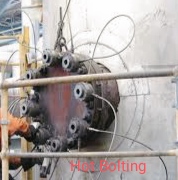Hot bolting is a critical maintenance procedure widely employed in various industrial sectors, including oil refineries, petrochemical plants, and power plants. This technique involves the replacement of bolts within a flange connection while the pipeline or equipment remains operational, thus allowing continuous service without significant downtime.
The focus of this article centers specifically on the paramount importance of achieving the requisite bolt force during the re-tightening process. The primary criterion under analysis is to ensure the maintenance of adequate gasket pressure during hot bolting to prevent any potential leakage when the bolt load is reduced.
To achieve this, a comprehensive solution is devised, taking into account several crucial considerations. The solution methodically accounts for the flexibility of the flange structure, as the removal of a bolt increases the distance between the remaining applied bolts. Consequently, this flexibility induces the most substantial reduction in gasket stress at the midpoint between the adjacent bolts and the location of the removed bolt. The resulting solution effectively determines the precise bolt stress required in the remaining bolts to meet the prescribed gasket pressure criterion.
This comprehensive approach encompasses various factors, including the gasket pressure criterion itself, flange flexibility, internal pressure, and flange loads, thus ensuring a holistic and accurate analysis. By implementing this comprehensive approach, industries can confidently execute hot bolting procedures, ensuring the integrity and safety of their equipment while minimizing the risk of leakage during maintenance activities. This method not only ensures efficient maintenance practices but also contributes to overall operational stability and cost-effectiveness.

Normal engineering prohibits working on live pipes. After the part is disconnected from the live stream, repair or replacement will be done in the off state. Working on live systems is always dangerous, so hot bolting should be performed after a thorough risk assessment and worker safety analysis. Great care must be taken and the benefits derived from hot bolting activities must be weighed against the associated risks.
Basically, hot bolting is part of a preventive maintenance procedure. Follow a set sequence to remove and replace nuts/bolts during the hot bolting process.
Table of Contents
Reasons for adopting hot bolting
There are many reasons for hot bolting pipe and equipment flanges. Some of them are:
- Hot bolting is a maintenance technique used to replace or tighten bolts on machinery or equipment while they are still in operation or under load. This allows critical systems to remain operational without the need for shutdown, reducing downtime and production losses.
- Hot bolting helps prevent equipment failures and leakage by ensuring that the bolts remain at their proper torque levels. This technology is commonly used in industries such as oil and gas, petrochemical and power generation where continuous operation is critical.
- It can be used to address loose, rusted or damaged bolts that may pose a safety risk or compromise the integrity of the equipment.
- Hot bolting can be used when immediate shutdown is not possible, providing a temporary solution until a scheduled shutdown can occur.
- Upgrading material specifications or bolt grades can be incorporated during hot bolting to improve equipment reliability.
- Hot bolting also helps reduce plant shutdown time by addressing bolting issues without the need for complete equipment shutdown during maintenance.
Hot Bolting Procedure
Here is the step by step procedure of hot bolting.
- Obtain permits and necessary approvals for hot bolting from safety professionals.
- Arrange all the required personnel, materials, and equipment at the worksite.
- Inspect each bolt for tightness, and promptly inform the responsible authority about any abnormal conditions.
- Follow the correct sequence provided by the operator for hot bolting, working on one bolt at a time. The usual sequence is: Remove -> Examine -> Clean -> Lubricate each bolt as needed -> Check if nuts can be reused -> Tighten the bolt.
- Dispose of any damaged/questionable bolts or nuts and replace them with new items, following the correct piping specification.
- Clean all exposed flange surfaces thoroughly.
- Once all bolts are replaced, conduct a final inspection to ensure proper tightness.
Advantages of Hot Bolting
Hot bolts have several advantages, including:
- Avoid unplanned shutdowns.
- Increase safety by replacing damaged bolts.
- Weak links are removed, thus improving joint integrity.
- Shorter switch-off times.
- Improved efficiency.
- Reduce the number of containment breaches.
- No downtime means uninterrupted production.
Risk Associated With Hot Bolting
- Loosening bolts on a hot system can release steam or dangerous chemicals, which can harm workers.
- Working on hot surfaces puts workers at increased risk of burns.
- Hot bolting can cause equipment failure or leakage if not done correctly.
- Workers can get their hands or tools trapped between moving parts when attempting hot bolting.
- The presence of flammable materials with hot surfaces may pose a risk of fire or explosion.
